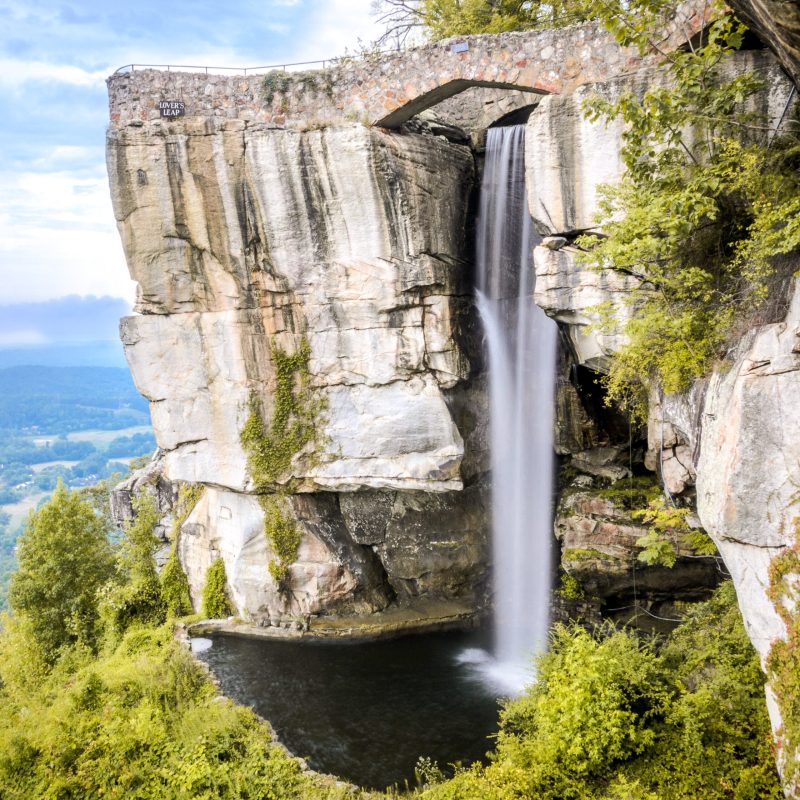
Note: The Travel Awaits team regularly updates content to provide the latest, and most accurate information to our readers. The updated content in this article may not reflect the views or opinions of the original author.
Videos by TravelAwaits
Tennessee, and in particular the Highland Rim and Cumberland Plateau, offers some of the most spectacular views in the U.S. The unique topography with its extensive system of rivers and streams makes Tennessee a top waterfall destination.
Many of the waterfalls are located in Tennessee state parks and are free to access. The best time to visit any of the waterfalls is during spring when snowmelt and spring showers birth striking cascades.

11 Magnificent Waterfalls In Tennessee
1. Twin Falls
Rock Island State Park, Rock Island
The Twin Falls, rather than falling over rock walls, pours out of a gorge. The waterfall was accidentally created when the Caney Fork River was dammed. The water pours out from the walls about 80 feet above the Caney Fork River. Although you’ll see other smaller falls along the walls, this waterfall is named Twin Falls after its two main streams of water.
Located in Rock Island State Park, the Twin Falls are easy to reach without any rugged climbing, but you will need to navigate the stairs down to the trail. The trail is an easy walk along the river, where you can view the falls from different angles. On the day I visited Twin Falls, Eric Jackson, a world-champion freestyle kayaker gave us a demonstration beneath the falls. But first he wowed our group of journalists by getting into the water from his kayak with a back flip from atop a cliff. Jackson lives nearby and can be found playing in the water when he’s not on tour competing.
While you’re in Rock Island State Park, you might want to visit the Great Falls, upstream from Twin Falls. The Great Falls is a cascading 30-foot horseshoe waterfall located below a 19th-century cotton textile mill. The waterfall powered the mill over 100 years ago. The Caney Fork Gorge runs below the Great Falls Dam and is a spectacular overlook along the Eastern Highland Rim.
Rock Island State Park is an 883-acre park where professional freestyle kayakers from around the world try to tame the whitewater under their paddles. Hiking and scenic overlooks throughout the park can easily fill an afternoon. In addition to Twin Falls and Great Falls, you can view Badger Falls, Badger Flat Falls, and Lower Great Falls. Those that aren’t accessible by trail can be viewed from overlooks.

2. Carmac Falls
Evins Mill Resort Near Smithville
The hike to Carmac Falls is steep but rewarding. It’s situated on the private property of Evins Mill Resort. This scenic property provides the amenities of a luxury destination but is run with the intimacy of a boutique resort.
Nestled among the forested bluffs and meandering streams of Tennessee’s Highland Rim and Cumberland Plateau, Evins Mill Resort is a designated Tennessee State Natural Area.
The out-and-back trail that takes you to Carmac Falls isn’t long at one mile round-trip, but it is a steep, climbing 90 feet.
Consider staying at the Evins Mill Resort in one of their creekside accommodations, or call ahead to reserve the day picnic-and-hike package for $25.

3. Fall Creek Falls
Fall Creek Falls State Park, Spencer
This park is home to stunning overlooks, waterfalls, and a beautiful gorge. Fall Creek Falls State Park is one of the largest and most visited state parks in Tennessee, encompassing more than 29,800 acres sprawled across the eastern tip of the Cumberland Plateau. Its namesake waterfall cascades 256 feet and is one of the highest single-vertical drop falls east of the Rocky Mountains.
In addition to waterfalls, you’ll find cascades, streams, and oak and hickory forests to hike and explore. Fall Creek Falls and Cane Creek Falls can be reached via a 2.4-mile heavily trafficked loop trail that AllTrails rates moderate. One hiker reports that there are slight inclines and declines along the trail, plus natural rock steps. “Moderate is a fair assessment as there are easy sections, but others that are a little strenuous,” according to the hiker. The best time for a visit is between March and October.
While you’re there, be sure to visit Coon Creek Falls, with its 250-foot drop and Rockhouse Falls, with its 125-foot drop. Smaller falls in the park include Cane Creek Falls, Cane Creek Cascades, and Piney Creek Falls.

4. Cummins Falls
Cummins Falls State Park, Cookeville
The eighth highest waterfall in Tennessee, Cummins Falls is one of the most visited in the state. The 211-acre park is located on the Blackburn Fork State Scenic River. The stream gives way to the 75-foot drop that creates Cummins Falls. This is a two-drop waterfall; the first 50-foot drop lands in a pool, then a second 25-foot drop lands in another pool. Travel + Leisure ranks Cummins Falls as one of the best swimming holes in the U.S.
The Tennessee State Parks website does warn: “While very beautiful, this is a rugged area and there are inherent hazards. To make your visit to our park as safe and enjoyable as possible, know the risks. Use good judgment and common sense when deciding whether you should hike down to the waterfall or view it from above, at the overlook. If you decide to hike to the bottom of the waterfall please use caution. Everyone should wear appropriate shoes that can get wet, bring a friend, and wear a PFD (personal flotation device) when swimming at the falls.”

5. Greeter Falls
South Cumberland State Park, 4 Different Counties
If you’re ready to hike backcountry, the Savage Gulf area at South Cumberland State Park is home to the Greeter Falls. This waterfall drops over a 15-foot upper ledge and then falls 50 feet to a large basin. The gorge is so steep that you’ll need to descend on a man-made spiral staircase to access the lower falls. Also in Savage Gulf? Savage Creek, which drops 30 feet at Savage Falls. In between the two waterfalls are additional cascades, waterfalls, and water wonders to explore.
Take the Greeter Falls Loop Trail to view three waterfalls: Upper Greeter Falls, Lower Greeter Falls, and Boardtree Falls.

Mountain Vacation Resorts / Wikimedia Commons (CC BY-SA 3.0)
6. Burgess Falls
Burgess Falls State Park, Sparta
Many comment that Burgess Falls reminds them of a smaller version of Niagara Falls. Located in Burgess Falls State Park, you’ll take a moderately strenuous hike on the 1.5-mile round-trip River Trail/Service Road Loop to the main waterfalls. Burgess Falls drops 136 feet. You can reach the bottom of the falls by kayak if you put in at the Cane Hollow Access point on Center Hill. There’s a trail from the main overlook to the bottom of the main falls, but the Tennessee Parks Department warns that it is very strenuous.
The park is located on the Falling Water River and is known for its natural beauty and four waterfalls. Originally populated by the Cherokee, Creek, and Chickasaw tribes, this land was used as a hunting ground until the late 19th century when a gristmill and sawmill began operation on the river. From 1928 to 1944, the Falling Water River was used to generate hydroelectric power for the city of Cookeville. Then in 1973, the area became a designated Tennessee State Natural Area, meaning its diverse forest and aquatic habitats are legally protected.

7. Lover’s Leap
Rock City Gardens Near Chattanooga
Rather than a state park, Lover’s Leap is located inside an amusement area at the top of Lookout Mountain near Chattanooga. You’ll hike the 4,100-foot Enchanted Trail exploring rock formations, caves, and a hanging bridge before arriving at Lover’s Leap.
Legend has it that the rock that juts out from the side of Lookout Mountain got its name from the Cherokee. Two young lovers, a brave named Sautee and a maiden named Nacoochee were from feuding tribes. As the story goes, Sautee was captured and thrown from the top of Lover’s Leap. Distraught, Nacoochee jumped to her death as well.
Your climb through the park takes you to the top to view the valley below where you’ll take in the scenery of seven states. Parts of Rock City are ADA accessible; more information is available here.

8. Ruby Falls
Chattanooga
Unlike the other waterfalls, which are predictably outdoors, Ruby Falls is located deep within Lookout Mountain. You’ll take an elevator to a cavern, then walk a paved, level pathway to the majestic falls. This tour isn’t recommended for anyone with claustrophobia as you are 1,120 feet below the surface of Lookout Mountain. The guided tour introduces you to various geological formations leading up to the sparkling 145-foot underground waterfall.
Want more amazing hikes and stunning natural scenery? Travel experts reveal their favorite U.S. national parks, and we recommend these eight beautiful Smoky Mountain hiking trails.
9. Laurel Falls
Great Smoky Mountains National Park, 3 Different Counties
Nestled in the Great Smoky Mountains and standing at 80 feet, Laurel Falls is recognized as one of the most popular waterfall hiking destinations in the Smokies.
The waterfall derives its name from mountain laurel, a plant that blooms near the falls and along Laurel Falls Trail. The path leading to admire Laurel Falls can be easily navigated by most visitors.
10. Ozone Falls
Ozone Falls State Natural Area, Crossville
The 43-acre natural area is home to bluffs, dense forests, and the 110 ft. Ozone Falls which was even featured in scenes of the movie, Jungle Book. The Falls plunge deep into a rocky pool and then reemerges several feet downstream.
You can get access to both the top and bottom cascades of the Ozone Falls while passing through the Cumberland Trail.
11. Foster Falls
South Cumberland State Park, Sequatchie
Located in South Cumberland State Park, Foster Falls is one of the most scenic destinations in South Tennessee. The hike to the Foster Falls is short and challenging, but the view from the bottom is simply spectacular. Foster Falls offers swimming opportunities, with plenty of rocks for sunbathing.
FAQs
How Many Tennessee Waterfalls Are There?
There are 874 waterfalls in Tennessee. While a vast majority of these are small and a great number are on private property, there are plenty of majestic spots for the public to enjoy, including more than 80 at Tennessee State Parks.
What’s the Biggest Waterfall in Tennessee?
At 256 feet, Fall Creek Falls is the highest waterfall in Tennessee and one of the highest waterfalls in the eastern United States. Other waterfalls within the park include Piney Falls, Cane Creek Falls, and Cane Creek Cascades.
When to Visit Waterfalls in Tennessee?
It’s best to visit Tennessee’s waterfalls in springtime when snowmelt and increased rainfall add to their flow. Waterfall viewing is a treat all year round though. Whenever you visit Tennessee waterfalls, remember the ‘‘Leave No Trace’’ ethics.
What Is the Best Waterfall in Tennessee for Families?
The Great Smoky Mountains National Park is a popular family vacation spot for good reason. The Laurel Falls Trail stands out as one of the most popular hikes in the Great Smoky Mountains. This waterfall is best for families who like to get an early start.
Which Tennessee Waterfall Was Featured in a Movie?
A little less than 2 hours from Nashville there is Ozone Falls. Ozone Falls not only captivates with its impressive 100-foot drop, but it was also where a lot of Disney’s Jungle Book was filmed. There’s a rock house behind the falls that was created by erosion and was also featured in the movie.
